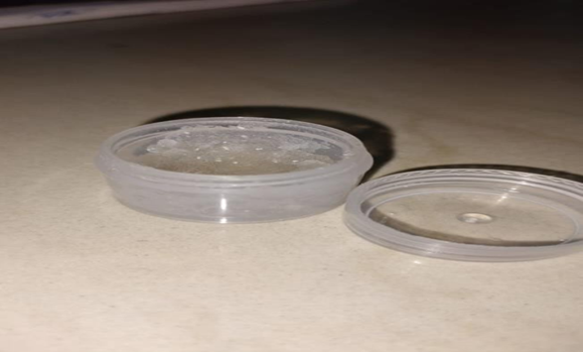Formulation and Evaluation of Ketoconazole Microsponge Topical Gel
Abstract
Microsponges are those drug delivery systems which are intended in a way to deliver a minimum dose of the drug or pharmaceutically active ingredient to increase the stability of formulation, to alter drug release profile. Ketoconazole is an imidazole anti-fungal agent belonging to BCS class II. The main objective of this research work is to formulate and evaluate ketoconazole microsponge for topical delivery by using various polymers such eudragit S-100, eudragit L-100 in four ratios 1:2, 1:3, 1:4, 1:5 by quasi emulsion method. The formulations prepared were labelled based on the ratios as ES 2. ES 3, ES 4, ES 5 for eudragit S-100 and EL 2, EL 3, EL 4, EL 5 for eudragit L-100. Evaluation tests like entrapment efficiency, production yield, drug content was performed and formulation of eudragit L-100 (EL 5) and eudragit S-100 (ES 5) showed better results. ES 5 and EL 5 formulations were optimized and tests like in vitro dissolution studies were conducted which showed that the formulation ES 5 showed released upto 8 hours and can be used in the formulation of gel. The gel (GES5) was prepared by usingmicrosponges containing the drug ketoconazole equivalent to 1 % w/w and was incorporated into the gel base made up of Carbopol 934. The microsponges were sieved and were dispersed in Carbopol gel. Evaluation tests like pH measurement, visual inspection, spreadability studies, drug content and in vitro diffusion studies. This method of formulating microsponges has improved drug delivery therefore helping in the enhancement of the bioavailability of the drug and also acts as an efficient carrier through the skin.
Full text article
References
A Kaundal, R Bhatia, A Sharma, and P Sukrial. A review on microsponges drug delivery system. International Journal of Advanced Pharmaceutics, 4(3):177–181, 2014.
P Pandey, V Jain, and S C Mahajan. A review: microsponge drug delivery system. Int. J Biopharm, 4(3):225–230, 2013.
S Sharma, S Pawar, and U K Jain. Development and evaluation of topical gel of curcumin from different combination of polymers formulation and evaluation of herbal gel. IJPPS, 4(4):452–456, 2012.
Disha Dutta, Naveen Goyal, and Dinesh Kumar Sharma. Microsponges. A Review on its Effective Topical Application. World Journal of Pharmacy and Pharmaceutical Sciences, 7(10):462–474, 2018.
Namrata Jadhav, Vruti Patel, and Siddesh Mungekar. Microsponge Delivery System: An updated review, current status and future prospects. Journal of Scientific and Innovative Research, 2(6):1097–1110, 2013.
Ayan Kumar Kar and Banhishikha Kar. A Novel Approach on Microsponge: Multifunctional Modern Dosage Form. Int J Pharm Sci Rev Res, 51(2):64–72, 2018.
H K Pathan, Ajay Saraf, and Amit Desani. Microsponge drug delivery system as an innovation in Cosmetic world: A Review. Asian Journal of Pharmaceutical Education and Research, 1(2):67–87, 2012.
Urvashi B Patel, Harshil M Patel, et al. A review-Recent research on microsponge a novel new drug delivery system. International Journal of Advances in Pharmaceutics, 7(3):10–16, 2018.
Nawal A. Rajab and Mohammad S. Jawad. Formulation and In Vitro Evaluation of Piroxicam Microsponge as a Tablet. International Journal of Pharmacy and Pharmaceutical Sciences, 8(2):104–114, 2016.
P D Borawake, A Kauslya, J V Shinde, and R S Chavan. Microsponge as an Emerging Technique in Novel Drug Delivery System. Journal of Drug Delivery Therapeutics, 11(1):171–181, 2021.
S C Jagtap, A A Karale, and A W Ambekar. Microsponge: A Novel Topical Drug Delivery System. Journal of Drug Delivery System, 3(4):1–9, 2014.
Jickyt Panicker and Shaiju S Dharan. Gastroretentive Floating Microsponges an Updated Review. International Journal of Pharmacy and Pharmaceutical Research, 15(4):213–222, 2019.
Imrankhan M Bhaishaikh and D A Bhagwat. Floating Microsponges as Gastro Retentive Drug Delivery System Containing Lafutidine to Treat Gastric Ulcer. Acta Scientific Pharmaceutical Sciences, 3(2):3–12, 2019.
Bipul Nath and Lila Kanta Nath. Design, Development, and Optimization of Sterculia Gum-Based Tablet Coated with Chitosan/Eudragit RLPO Mixed Blend Polymers for Possible Colonic Drug Delivery. Journal of Pharmaceutics, pages 1–9, 2013.
Mishra Pooja. Formulation and evaluation of Microbial Triggered Colon Specific Delivery of Azathioprine. World Journal of Pharmaceutical Research, 4(9):1597–1615, 2015.
Samir A Atara and Moinuddin Soniwala. Formulation and evaluation pectin-calcium chloride beads of azathioprine for colon targeted drug delivery system. International Journal of Pharmacy and Pharmaceutical Sciences, 10(1):172–177, 2018.
Popat B Mohite et al. Derivative spectrophotometric estimation of azathioprine in bulk drug and pharmaceutical dosage forms. Analytical Chemistry An Indian Journal, 8(1):54–55, 2009.
Shailendra Kumar Singh and Priti Girotra. Formulation Optimization for Colon Targeted Delivery of Katira Gum Matrix Tablets Containing Azathioprine. International Journal of Pharmaceutical Sciences and Drug Research, 5(4):133–140, 2013.
Authors

This work is licensed under a Creative Commons Attribution-NonCommercial-NoDerivatives 4.0 International License.





